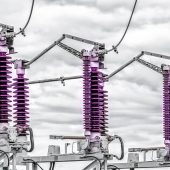Many of the electrical issues we encounter on a day-to-day may be caused by or lead to electrical current failure. While it is almost natural to get a technician to come and test for the presence of current in a given circuit, with the best voltage tester, you can do that on your own
Why Buy A Voltage Tester?
Voltage testers have become a must-have in homes and business premises. This is because of their usefulness in detecting the flow of electric current and whether it has proper grounding. That is not all, you can use this equipment to determine the adequacy of voltage present in a wire.
There is the option of using a digital multimeter to do the same job, but this instrument is comparatively complex and costly. The voltage tester is designed in such a way that it protects you from any accidental electrical shock that may result from the testing.
Types of Voltage Tester
There are three main types of voltage testers or detectors: two-contact, one-contact, and non-contact.
1. Two-Contact Voltage Meters
The design of this tester resembles a screwdriver. The lamp is connected between the tip of the tester and a single lead projecting out from the back of the tester.
The flying lead is connected to a ground reference while the tip of the tester is brought into contact with various points along the circuit. This assembly makes it possible to determine the presence or absence of voltage at every point. In turn, this allows for simple faults to be detected as well as traced to find the root cause.
In case the circuit you are testing carries high AC voltages of about 2,000 or higher, you can use a statiscope comprising a neon glow tube that is mounted on a long handle. The voltage tester lamp used for low voltage work is usually a small, incandescent light bulb. When exposed to high voltages, these lamps fail or may even result into a short circuit in the tester.
The disadvantage of two-contact voltage meters is that they put you in close proximity to live circuits. This exposure may cause electrical shocks or short circuits. Most of the homemade test lamps though inexpensive, do not have sufficient protection from high energy faults.
It is a common practice for the test lamp to be connected to live circuits before and after the voltage testing has been done. This serves to check if the test lamp is still operational or it has failed.
2. One-Contact Voltage Testers
This is just not one of the best voltage tester, but also an improvement from the two-contact tester. As its name suggests, this tester contacts only one side of the circuit under test. To complete the circuit, it relies on stray capacitance and the current that passes through your body.
Different designers have come up with varying shapes with some testers resembling screwdrivers. The tip of the tester is usually touched to the conductor which can be a wire in a switch or an insertion through an electric socket hole. The light that comes with one-contact voltage testers is a neon lamp that requires minimal current to light. This is why it can comfortably use your body’s capacitance to complete the circuit.
The disadvantage of these screwdriver-type voltage testers is that their construction may not be sufficient to protect you against shock hazard. For instance, in testers where the shaft is exposed, a risk of you being shocked exists. To add to that, there is no protection for whatsoever provided for in the internal construction to prevent short circuiting faults.
Where the lamp and resistor series network fail, you may find yourself in direct metallic contact with the circuit you are testing. Even in cases where the resulting shock from internal short circuit is not strong enough to electrocute you, it can result in a fall or other forms of injury.
The lamp doesn’t provide any indication below its strike voltage and this means detecting certain hazardous leakage conditions becomes almost impossible.
The reliance of one-contact voltage tester on capacitance in order to complete the circuit makes it somewhat unreliable when determining direct-current potential. For instance, if you are isolated from the ground and coupled to other nearby live wires, dead circuits may indicate false positives while live circuits may indicate false negatives when testing.
3. Non-Contact Voltage Testers
These testers do not come into contact with the circuit being tested. They rely only on capacitive current and can detect with precision any changes in electric field around objects that are AC energized.
The only thing you have to do is to touch the top of the handle to give the tester a ground reference. If the conductor under test is live, the indicator LED will light up and if it uses a speaker, it will buzz. There is a small internal battery that provides the energy required to light the lamp and ensure the amplifier is powered. There is no current that flows through the user’s body.
Some non-contact voltage detectors may give brighter light or louder buzzes to indicate stronger detections. These testers also come with their limitations. For instance, they cannot detect DC voltage because it doesn’t pass through capacitors. Non-contact testers that sense electric fields cannot be used to detect voltage inside armored or shielded cables.
4. Receptacle Tester
This type of tester plugs into a socket and is useful for detecting various types of wiring errors. The 3 lights combine to show the specific errors in wiring. Some of the errors you can detect with receptacle testers include missing electrical ground or neutral, reversed hot or neutral among others.
What to Look for When Buying a Voltage Tester
There are different models and brands of voltage testers out there. As you would expect, they are priced differently from a few pounds to even a hundred pounds for the fancy testers with lots of features. A good quality voltage tester should cost you about £15 – 50.
Pricing should not be the only determinant because safety is even more important. Go for brands that are on all the time because you may need to leave the tester in place as you observe from a distance. Switch-dependent testers can be challenging to work with in such scenarios.
The voltage is another important consideration. Be clear on what you want to use the detector for and pick one with an appropriate voltage range. Most of them come with a range of 50 to 600 volts or even more.
Though not very significant, you may choose voltage testers that use AAA batteries instead of watch style batteries. This is purely an argument based on the availability of AAA-size batteries.
The Best Voltage Tester Reviews
1. Kewtech KT1790 Voltage Tester
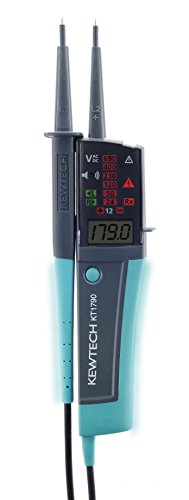
This voltage tester is slender in design, bright, and clear. Its luminous LCD and LED voltage indicators are clear making it almost impossible to miss a signal. It has a tone that is clear and audible enough to pick it out. Because of its construction, it can easily fit into recessed terminals without the need to unscrew caps.
Its key features include:
- Can detect both AC and DC voltage up to 690 volts
- It can carry out continuity test, single pole phase test, self-diagnostic test, and phase rotation test.
- It is dustproof and water resistant
When not in use, it auto powers off.
2. Fluke T110 Voltage Continuity
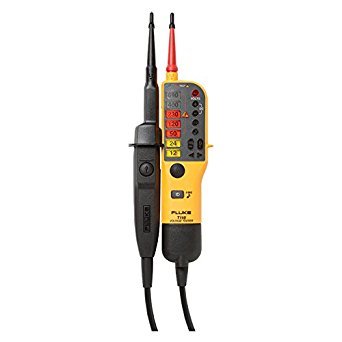
This is a two-pole voltage tester constructed to last you a long time. Thanks to its ergonomic design, it is easy to use and feels good in your hands. It comes packed with lots of features including:
- The ability to detect both AC and DC voltage through an audible continuity test, a visible LED indicator, vibration for tactile feedback, and a bright display of the measurement value.
- Excellent Cat III 690V and Cat IV 600V safety rating.
- Backlit indicators and graduated scale for clear readings.
- The ability to turn audio on and off when testing in noisy or quiet areas makes it one of the preferred best voltage tester in the market.
- RCD functionality and 3-phase systems rotation indicator
When the battery is low, you get a notification but the tester can still detect voltage.
3. Megger TPT320 Voltage Tester
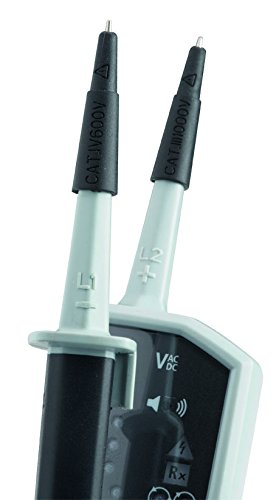
This is a versatile voltage tester that comes with a host of features and functions beyond voltage indication.
- It provides both LED and LCD displays
- It measures DC and AC voltage ranging from 12 to 690 volts
- Its continuity function starts from 0 to 500 kΩ
- The tester also has a Cat IV 600V rating
- There is a bright LED torch that comes in handy when working in poorly lit environments
- The phase rotation indicator that comes with this tester is highly simplified to avoid the crossing of test probes
Inasmuch as this tester is predominantly used for electrical installations, it can also be useful in other applications such as testing of fire alarms and electrical systems.
4. DL6790 CombiVolt Continuity Tester
This tester is slightly rugged and ergonomically designed for perfect handling. It is a three-in-one tester with lots of features making it one of the best voltage tester.
- It tests both DC and AC voltages starting from 12 to 690 volts.
- It can also handle DC and AC continuity testing with audible acoustic and clear optical indication.
- The voltage is indicated on a digital interface
- When the batteries are discharged, the tester will continue working as normal.
- Doesn’t trip any RCD when testing across earth and live
When testing in dark environments, there is an electrical torch function. Thanks to the probe tip protection, the risk of injuries is significantly reduced.
5. Martindale VT12 Voltage Continuity Tester
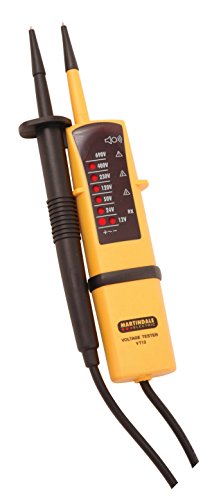
This two-pole voltage indicator has automatic range detection and AC and DC voltage detection. With a pocket-friendly weight of 130 grams, this is one of the best voltage tester you can carry everywhere you go comfortably. It is constructed with the latest safety standards.
- It can test both DC and AC voltage up to 690V
- It has bright, clear LED indication
- It has a safety rating of CAT IV 300V and CAT III 690V
- The continuity LED indicator illuminates to indicate circuit continuity from 0 to 200 kΩ
- When using the tester as a single-pole phase detector, the phase LED accurately indicates the presence of AC voltage
- There is a buzzer that sounds when the voltage present in the circuit is above the 50V ELV threshold or AC voltage is detected.
The manufacturer recommends that this tester be operated for a maximum time of 30 seconds followed by a recovery period of 4 minutes.

